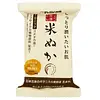What's inside
What's inside
 Key Ingredients
Key Ingredients

No key ingredients
 Benefits
Benefits

 Concerns
Concerns

 Ingredients Side-by-side
Ingredients Side-by-side

O-Cymen-5-Ol
AntimicrobialDipotassium Glycyrrhizate
HumectantGum Base
Bentonite
AbsorbentKaolin
AbrasiveDextrin
AbsorbentCitric Acid
BufferingGlycerin
HumectantCharcoal
AbrasivePapain
Skin ConditioningAscorbyl Palmitate
AntioxidantButylene Glycol
HumectantWater
Skin ConditioningCI 77499
Cosmetic ColorantTocopherol
AntioxidantCopper Tripeptide-1
Skin ConditioningCeramide AP
Skin ConditioningParfum
Masking
 Reviews
Reviews

Alternatives
Ingredients Explained
These ingredients are found in both products.
Ingredients higher up in an ingredient list are typically present in a larger amount.
Parfum is a catch-all term for an ingredient or more that is used to give a scent to products.
Also called "fragrance", this ingredient can be a blend of hundreds of chemicals or plant oils. This means every product with "fragrance" or "parfum" in the ingredients list is a different mixture.
For instance, Habanolide is a proprietary trade name for a specific aroma chemical. When used as a fragrance ingredient in cosmetics, most aroma chemicals fall under the broad labeling category of “FRAGRANCE” or “PARFUM” according to EU and US regulations.
The term 'parfum' or 'fragrance' is not regulated in many countries. In many cases, it is up to the brand to define this term.
For instance, many brands choose to label themselves as "fragrance-free" because they are not using synthetic fragrances. However, their products may still contain ingredients such as essential oils that are considered a fragrance by INCI standards.
One example is Calendula flower extract. Calendula is an essential oil that still imparts a scent or 'fragrance'.
Depending on the blend, the ingredients in the mixture can cause allergies and sensitivities on the skin. Some ingredients that are known EU allergens include linalool and citronellol.
Parfum can also be used to mask or cover an unpleasant scent.
The bottom line is: not all fragrances/parfum/ingredients are created equally. If you are worried about fragrances, we recommend taking a closer look at an ingredient. And of course, we always recommend speaking with a professional.
Learn more about ParfumWater. It's the most common cosmetic ingredient of all. You'll usually see it at the top of ingredient lists, meaning that it makes up the largest part of the product.
So why is it so popular? Water most often acts as a solvent - this means that it helps dissolve other ingredients into the formulation.
You'll also recognize water as that liquid we all need to stay alive. If you see this, drink a glass of water. Stay hydrated!
Learn more about WaterGum base isn’t an INCI ingredient and is a mixture of various materials.
It typically includes food-grade polymers, plasticizers, waxes, softeners, and fillers, with common components like natural rubber, polyvinyl acetate, and polyisobutylene.
Because formulations are proprietary, manufacturers can simply list it as "gum base" on labels. In the U.S., the FDA permits 46 approved substances to be used under this general term.
Learn more about Gum Base